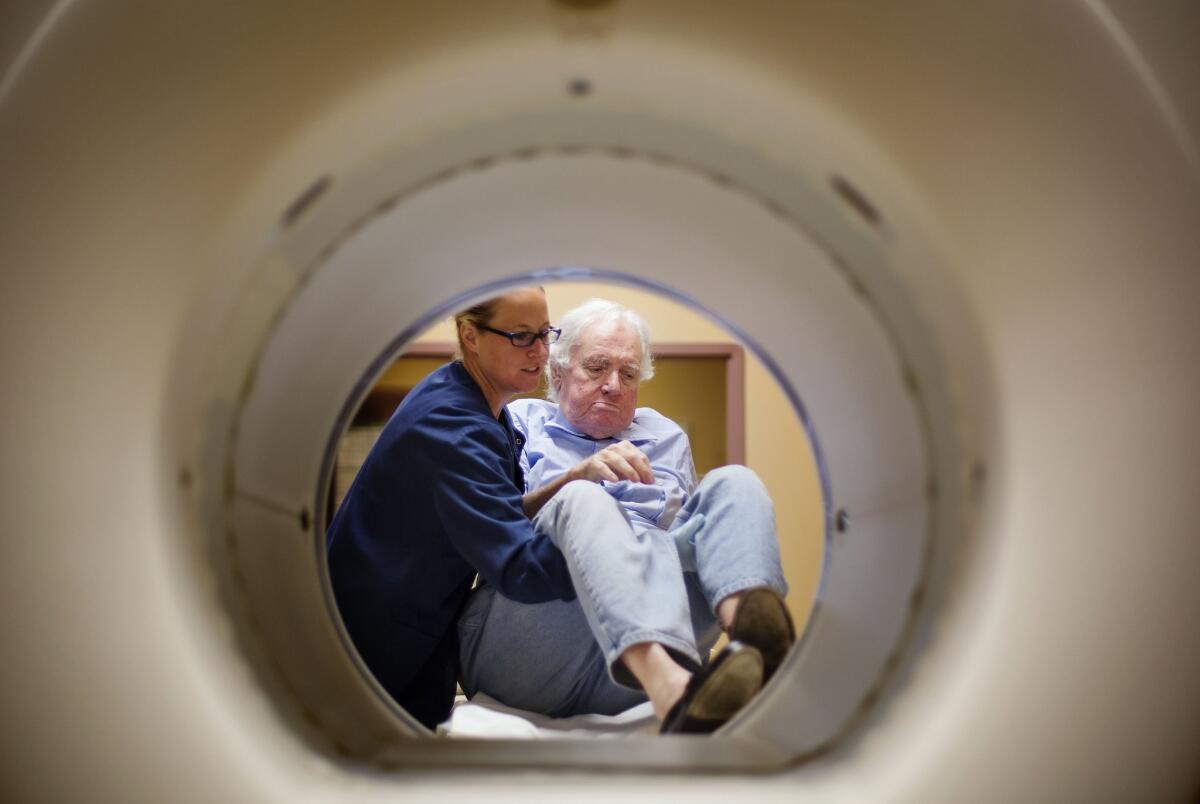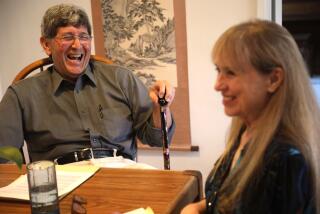Op-Ed: We should look less hard for cancer

A man in is helped off a table by a technician after undergoing a CT scan.
Thereâs a new cancer treatment strategy in the news: Wait and see. Time magazine ran a cover story on simply watching small breast cancers; the Wall Street Journal similarly reported on watching small thyroid cancers. So-called watchful waiting has been a long-standing option for early prostate cancers.
Wait and see is a strategy that acknowledges that some cancers are overdiagnosed: They do not need treatment because they do not pose a threat to health. But while watching small cancers avoids the harms of unnecessary treatment, it likely causes patients to worry about their future. That canât be good for their health.
Wouldnât it be better to simply not find these cancers in the first place? We need another new strategy: Look less hard for cancer. Call it low-impact screening.
The way to find a more appropriate amount of breast and thyroid cancer is to forget about the small stuff, the tiny abnormalities.
Consider the search for prostate cancer. PSA screening has been discouraged because it causes many men to be diagnosed with prostate cancers that are not destined to ever bother them. It has become the poster child for cancer overdiagnosis. But the problem is less about the assay itself and more about how we chose to use it.
Screening is not one thing; itâs a process. A colleague once compared it to a machine with a lot of dials to adjust. There is a dial for what age to start testing, a dial for what age to stop, a dial for how often to test and a dial for what constitutes an abnormal test, which controls how aggressively doctors look for cancer during each test.
If we want to find fewer prostate cancers, the dial for what constitutes abnormality is the one we most need to readjust. At first, the dial was set at a PSA of 4. Below 4 was ânormalâ; 4 or above was âabnormal.â A little more than a decade ago, some urologists argued that the dial should be turned down to a PSA of 2.5. That was the wrong direction. It led to more overdiagnosis.
Turn the dial the other direction. A higher abnormal PSA threshold would mean fewer men would be told they need a biopsy, reducing false alarms and overdiagnosis.
Urologists can better hone the group who should be biopsied with further adjustments: age-specific PSA thresholds, adjusting the threshold for prostate size and, most important, making use of the diagnostic value of time, measuring how fast PSA is rising. Such adjustments should be guided by data, so that the number of men told they require intervention more closely approximates the number expected to develop serious cancer.
Because the PSA test produces a single number, itâs easy to see where the abnormal test dial is set. Itâs harder for thyroid and breast cancer tests because they use images to search for cancer.
But the dial is clearly being turned the wrong way in breast cancer. Everyone seems to be trying to find more, with 3-D mammography, molecular breast imaging and MRI imaging. And yet we know statistically that many, if not most, of these additionally discovered cancers will not develop into serious health problems in the next decade.
The way to find a more appropriate amount of breast and thyroid cancer is to forget about the small stuff, the tiny abnormalities. Turn the dial to focus on the larger abnormalities, perhaps a centimeter or larger. As the data come in, adjust the target size so that, again, the number of patients told they will need intervention more closely approximates the number that can be expected to develop serious cancer.
Of course, raising the threshold for an abnormal PSA or a mammogram will invariably mean some cancers will not be detected as early (whether these patients are worse â or better â off is a separate question). But it will also mean fewer people will be told they have cancer, fewer will be pushed into treatment they do not need and fewer will have to wait and see.
In truth, there is no perfect setting for any of the testing dials. Even the American Cancer Society acknowledged this in new breast cancer screening guidelines released last month. The society now recommends that women have fewer mammograms, and it acknowledges that womenâs preferences play a role in setting the dials of when to start, how frequently to test and when to stop.
Maybe patients should also have a choice about how hard doctors look.
Cancer screening is not just about science, itâs also about value judgments in the face of uncertainty.
Its benefit is much less frequent than we generally acknowledge â on the order of one person per 1,000 may be helped to avoid a cancer death by a decade of screening. Then there is the question of whether this actually translates into âsaving livesâ â lowering the overall death rate â or whether a small deficit in cancer deaths is matched by a small surplus in deaths due to other causes.
The harms of screening, on the other hand, happen here and now. False alarms, biopsies, biopsy complications, overdiagnosis, treatment and treatment complications all occur soon after testing. And all this costs real money, increasingly coming out of individualsâ pockets. And screening can rapidly change oneâs perception of health, turning a well person into a patient, often unnecessarily.
Given these trade-offs, some will choose to be screened, believing itâs always better to be safe than sorry. Others will choose not to be screened, understanding that itâs not immediately clear which strategy is safer and which is more likely to make one sorry. But maybe itâs time to offer a screening middle ground, one that doesnât attempt to find everything, and mitigate the problems of false alarms and overdiagnosis.
H. Gilbert Welch is a professor of medicine at the Dartmouth Institute for Health Policy and Clinical Practice and the author of âLess Medicine, More Health â 7 Assumptions that Drive Too Much Medical Care.â
Follow the Opinion section on Twitter @latimesopinion and Facebook
More to Read
A cure for the common opinion
Get thought-provoking perspectives with our weekly newsletter.
You may occasionally receive promotional content from the Los Angeles Times.










